Rivers, if you ever read this, I have to apologize. It seems like every article where you’re interviewed or discussed has an eye roll-inducing pun in the title and I just… I couldn’t resist. I promise I’m at least 30% more clever than this. [citation needed]
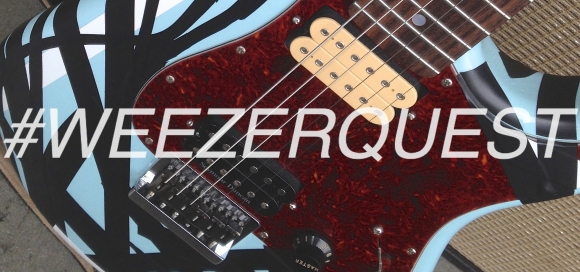 Our ragtag Weezer tribute band My Name Is Jonas Brothers played an absolutely kick-ass gig back on Black Friday, and the crowd was one of the best I’ve ever encountered. People were screaming lyrics, having a blast, and after the show I was told more than once that we sounded just like Weezer in the ‘90s, even that a few concertgoers had been “trying to see us” for some time. That felt special. Then I realized I’ve been slacking, and I know that perhaps tens of you are foaming at the mouth for more insight into our little labor of love.
Our ragtag Weezer tribute band My Name Is Jonas Brothers played an absolutely kick-ass gig back on Black Friday, and the crowd was one of the best I’ve ever encountered. People were screaming lyrics, having a blast, and after the show I was told more than once that we sounded just like Weezer in the ‘90s, even that a few concertgoers had been “trying to see us” for some time. That felt special. Then I realized I’ve been slacking, and I know that perhaps tens of you are foaming at the mouth for more insight into our little labor of love.
It’s Dangerous to Go Alone
WHEN WE BEGAN talking about the idea that would later be #weezerquest (so coined by Instagram follower and frequent commenter Dan Murphy) the only stipulation we made was as follows: Unless we were willing to put in the effort to nail those tones, we may as well not even do it. Look, there are plenty of Weezer tribute acts out there, many of which are really good bands. (At the time of this publication, there are at least three other active tribute acts in Seattle alone) However, we weren’t interested in simply being good; our goal was authenticity.
This meant A LOT of research.
I’ve Got Electric Guitar
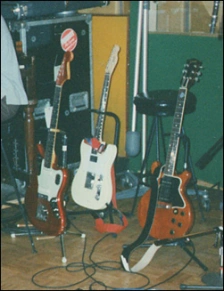
Ric’s CAR Jaguar (used mainly for cleans, most notably on “Say it Ain’t So”) and the Les Paul Special DC. Photo source: Weezerpedia
If there’s one thing Weezer is known for, it’s their towering, nigh-impenetrable wall of guitar, but you might be surprised to learn that the band’s first record (affectionately known as “Blue” by fans) did not rely on humbuckers to get that sound. P90s, actually.
Blue’s heavy sound is almost entirely made up of Rick Ocasek’s ’59 Les Paul Special DC run through Rivers’ distorted Mesa Mark I, as well as a Marshall SL-X for some other tracks. As much as I wanted to remain authentic, I chose early on to strike a balance between Weezer’s thick studio sound and their raw live and Pinkerton-era tones. So, instead of dropping ~$5k on a vintage guitar, I focused instead on the guitar I most associated with Weezer: Rivers’ iconic “Strat with the lightning strap.”
Wearing mismatched pickups and a hardtail bridge, Rivers’ famous Blue Strat from the ’94-’01 era was the thing I idolized, so the chance to recreate it was what truly excited me in the first place. The Blue Strat isn’t a stock model, but rather an instrument purpose-built from using parts from Warmoth. It can be seen on the inside gatefold of the Blue album, and in just about every performance and promo shot of the band for 6 or so years. Having thought about that guitar for 20 years, I began collecting any images or notes I could find; there were brief excerpts from mid-‘90s interviews, disposable camera scans, and about 70 blurry screenshots from the “Say It Ain’t So” and “Undone (The Sweater Song)” videos to help me nail down the parts I needed to find.
I may have gone completely overboard.
The Hundred Acre Woodshed
Over a very short period of time, I had amassed over 200 reference images. Sadly, other than the pickups, there really isn’t a lot of concrete info to go on, and working off of decades-old blurry photos isn’t an ideal way to view obscure parts. Full disclosure: I’m not bold enough to call up Weezer themselves and ask them if they would 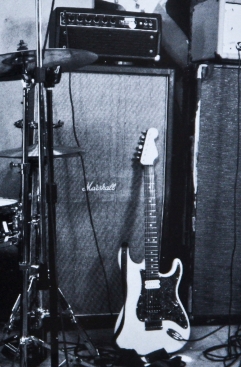 please answer my particularly nerdy questions.
please answer my particularly nerdy questions.
In a very short time, it became obvious that Rivers’ guitar isn’t just any Sonic Blue double fat Strat. What I had previously assumed to be a cobbling together of available parts seemed more to me like a completely intentional build, specific to Rivers’ Hair Metal-influenced technique and the perceived shortcomings of his previous instruments. Whether or not this is true is pure speculation, but in following the breadcrumb trail of his prior employs to this guitar, a methodology certainly emerged.
Thanks to the efforts of other Weezer-obsessed fans, and mainly to Weezer Historian and Tech Karl Koch, we are blessed with Weezerpedia, which has, among bios and background info on rare songs, a rather comprehensive equipment timeline for each member. Because of this, I was able to get a basic sketch of the guitar I was replicating.
X-Ray Specs
From photos, we know that The Blue Strat is a hardtail model with 22 frets, rosewood fingerboard, with a tortoise shell pickguard mounted to its blue body. Thanks to Weezerpedia, we also know that Rivers’ chosen pickup combo is a black Seymour Duncan TB59 in the bridge and a creme DiMarzio Super II in the neck, both F-spaced. Watching Rivers switch pickups during televised performances confirmed my suspicions that his electronics were as simple as they could get: a three way switch and a master volume and tone. (Actually, it’s not a tone knob, but we’ll get to that in a bit)
Other parts were more difficult to discern. For one, I could only find one really good shot of the tuners, which only shows me the shape of the buttons, which I combined with a side shot from the “Say it Ain’t So” video to determine that they are Sperzels. A lack of reflections led me to believe they were finished in satin chrome.
Another brief mystery surrounded the control knobs, which I assumed were the usual black V/T combo, but to my surprise, they’re both marked VOLUME. Although I had two volumes on my guitar for a while, I ended up with a “MASTER” knob, which turned out to be from a late ‘70s Fender Starcaster. I thought that was more badass, so I deviated from authenticity there. Booooooooo.
However, one question held up my work longer than any other: “What the hell is that bridge?”
***
Like I said, we know the guitar has a hard tail bridge, and photos of the back of the body clearly show string ferrules. Easy, right? Not at all, really. Compare this everyday hard tail bridge to a screen shot of Rivers playing The Blue Strat:
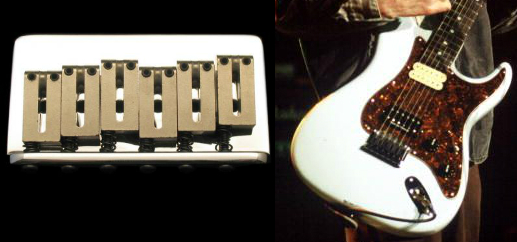
Seriously, what the hell is that? That fat sustain block tells me it’s some kind of ‘70s/‘80s thing, but without ultra-clear shots, I really didn’t know where to start. In the end, this question stole over ten hours of my life.
I searched high and low for information about the particulars of this bridge, but found nothing. After hours leafing through photo after photo, I turned to Rivers’ metal roots for inspiration. While paging through old Charvel catalogs, I stumbled upon the Jake E. Lee model, which originally had a bridge eerily similar to the one on the Blue Strat, its visual negative twin. That led me to interviews with JEL, and finally, Charvel brass bridges.
Behold ST111: 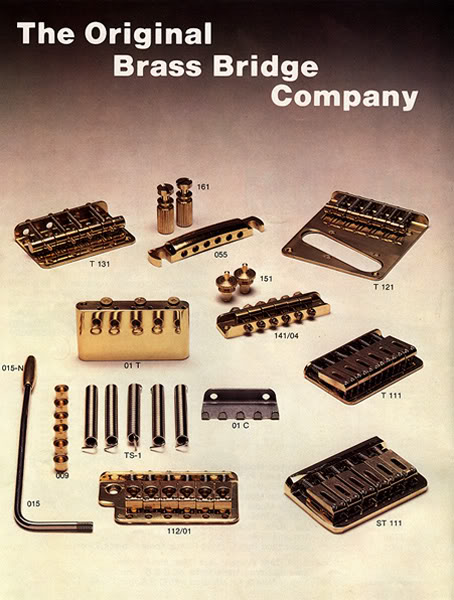
That’s the one there in the bottom right corner. In this shot, it’s unplated, but it has that unmistakable machined sustain block and elongated saddle design not found on any other aftermarket bridge.
Now that I knew what I was looking for, actually finding it was a fool’s errand. I searched over 10,000 eBay listings for multiple search terms like “brass Strat bridge”, “Charvel Jake E Lee” (to which it is similar) and even “hard tail guitar bridge”. Nada. Zip. Big fat goose egg.
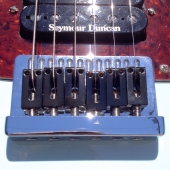 I never actually found an exact duplicate of Rivers’ bridge, but thanks to Aaron Pinto from Tumblr, I was able to order a Japanese Allparts replica that was more than adequate for my needs. Though the string spacing is slimmer than on the original Charvel, not to mention that the black plating has already worn off, but it’s close enough in look and sounds unbelievably good.
I never actually found an exact duplicate of Rivers’ bridge, but thanks to Aaron Pinto from Tumblr, I was able to order a Japanese Allparts replica that was more than adequate for my needs. Though the string spacing is slimmer than on the original Charvel, not to mention that the black plating has already worn off, but it’s close enough in look and sounds unbelievably good.
Don’t worry, though, I’m still looking for that exact bridge.
Building a Mystery
When it came to things like nut width or fret size, I used my best judgment, making educated guessed and allowing personal bias to dictate spec choices.
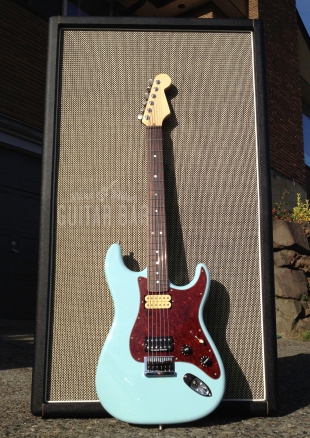 NECK
NECK
-Stratocaster
-Maple
-Satin nitro finish
-Rosewood fingerboard
-1 11/16″ nut width
-10”-16” compound radius
-22 frets
-Pearl dot inlays
-Black Corian nut
-Sperzel locking tuners
BODY
-Stratocaster
-2 HB routing
-Sonic Blue finish
-Hardtail bridge option
-WD tort pickguard
-reissue Charvel Jake E. Lee style bridge
ELECTRONICS
-Seymour Duncan Trembucker ’59 F-Spaced (8.3kohms)
-DiMarzio Super II F-Spaced (8.7kohms)
-500k CTS Volume
-250k (275K, actually) tone
-On board distortion from two 1n34a ‘cat whisker’ diodes wired in reverse parallel and in place of a tone cap
Warmoth could not have done a better job with these parts. The body is the exact color I wanted (Sonic Blue can be hard to accurately reproduce in photos, and paint batches can vary in color as well) and the neck was beautifully finished in satin nitro. Surprisingly, they made it out of beautiful flamed maple, which was a nice surprise. The fit between body and neck was tight in the best way possible, and unlike some other companies I’ve worked with in the past, there was no need to modify the pickup routs or control cavities for the parts to be installed. I’ll say that the guard may be a bit too red, so maybe I’ll try for a darker, more brownish one in the future. All things considered, it’s otherwise dead-on!
Impressions:
Before I had even plugged in, I knew it was going to be an especially fun guitar to play. That bridge, though –– THAT was the real secret to nailing the classic Weezer sound.
That massive, heavy brass hard tail bridge makes the guitar sustain and ring out like no other Stratocaster I’ve ever played. Booming low end, snarly mids and loud, rich highs abound, while pinch harmonics just jump out of the thing. Strumming full chords feels totally metal, even when played acoustically. I’ve always preferred hard tail Strats to the trem-equipped variety, but I’ve never heard one quite like this. In Eb tuning, this guitar is beastly.
Plugged into the Fender Excelsior Pro at the shop, more elements of Rivers’ sound started to make more sense, too. Both pickups are a bit more polite than you might expect given Rivers’ wildly overdriven tone, the DiMarzio Super II measuring at 8.7k and the Duncan TB-59 at 8.3k. I was initially worried about the neck pickup being slightly hotter than the bridge, but they balance out surprisingly well in their positions.
With many modern players gravitating toward hot pickups, there is a tendency to default to louder models for thickened tones. I’d argue that there is sound logic in the choice of lower-output pickups when you’re looking to get heavy: muddying up a muddy, loud pickup results in – you guessed it – a muddier sound, but over-overdriving a really clear, not too hot pickup results in this crunchy, thick sound that takes me right back to the golden days of Weezer every time I plug in. Allowing the amp to do most of the heavy lifting really brings out the punchy nature of the guitar.
I’m already a fan of the Duncan ’59 pickup, but I was shocked by the usefulness of such a bright neck pickup. I mean, the Super II is a LOT brighter than I expected, but suddenly those big chords with the low 5th sounded bigger, and some of the solos I loved from Blue sounded more “right” than ever. When I finally plugged into my Marshall rig, this guitar positively shakes the Earth.
On Thin Ice
As mentioned on Weezerpedia, Rivers had a Black Ice module installed in his guitar, a passive overdrive that takes the place of a tone cap and creates a tweed-like drive. It was difficult for me to guess at just how important this feature was to the overall character of his sound.
The Black Ice module as it used to be is a pretty neat little device, but they’ve recently overhauled the design so that more gain is available in different wiring configurations. Originally, I had planned on buying the real thing, but because the old unit had only the one sound, I got lost in all of the wiring options. Then I found this Instructable and ordered some 1n34a “cat whisker” diodes and wired them as described. How does it sound? Unbelievably good! Listen for yourself:
That sounds great, right? I was really surprised at how much I liked it, and I’ve made good use of my secret weapon in subsequent non-Weezer gigs. When covering Weezer songs, I’m using the diode distortion in conjunction with an overdriven amp, thickening the guitar’s voice while slightly dampening the high end. If you’re curious about how it stacks with other gain sources, here’s a video of how the circuit performs when matched with my Crowther Hot Cake. And here’s how it sounds in a live setting!
Letterman Jacket
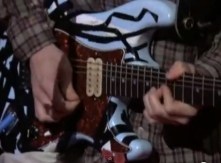 After our first show just a week after the Blue Album’s 20th anniversary, I decided to have some fun with the many electrical tape designs the guitar wore during Weezer’s touring cycles, thanks to Karl. I picked my favorite design –– specifically, the one seen in the “Say It Ain’t So” video and Weezer’s performance of that song on Late Night With David Letterman in 1995 –– and set about copying it as closely as possible.
After our first show just a week after the Blue Album’s 20th anniversary, I decided to have some fun with the many electrical tape designs the guitar wore during Weezer’s touring cycles, thanks to Karl. I picked my favorite design –– specifically, the one seen in the “Say It Ain’t So” video and Weezer’s performance of that song on Late Night With David Letterman in 1995 –– and set about copying it as closely as possible.
I already had plenty of photos, but because of Rivers’ right arm positioning, I couldn’t quite make out what was going on with the black tape at the arm contour, so I traced the lines and their most probable paths. Thankfully, the Letterman performance had a few much-needed camera angles, allowing me to see what happens to the tape as it rounds the Stratocaster’s two horns. I couldn’t be more proud of the end result.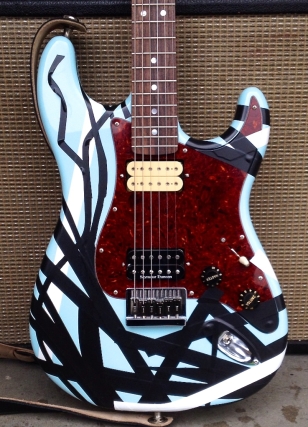
AMP RIG
Putting together the perfect amp rig for this was a bit easier than the guitar since not as many ambiguities exist on that side of the project. You can read about the many amp rigs of the band, but as I see it, there are two main amps of note:
As we know from Karl Koch recounting the early days, Blue and the shows and tours surrounding it relied on a Mesa Mark I amp head, one of the earlier ones with the rear-mounted presence knob. This amp is, sadly, long-lost at this point. Some months ago, we happened to take in a Mesa “Son of Boogie” amp that sounded really great, but I’ve just never been able to get on with Mesa amps personally, so I didn’t spring for it. It did sound incredibly close to that early Weezer sound, but I have a bias (amp joke) toward British amps.
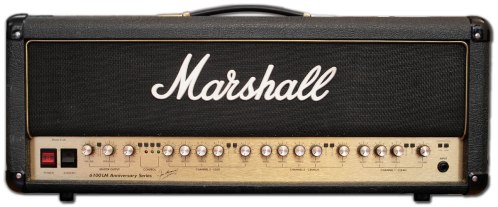 During the ’95 tour and Pinkerton recording sessions, Rivers used a Marshall 30th Anniversary 6100LM head, an amp with three channels, pentode/triode switching, an effects loop and a host of other features that make it extremely versatile. Karl tells that Rivers “borrowed” one from the Cranberries for their Lettermen performance when his SL-X picked up a “horrible sounding hum” and purchased his own shortly thereafter. He gravitated toward channel two, which has three separate modes to cover the sounds of the JTM45, Superlead Plexi, and JCM800/900 era of Marshall sounds. This was his main amp both live and in-studio until 2001, when it was relegated to road use. If you look closely, you can tell that Rivers’ 6100LM is in fact the less-liked 5881/6L6 version.
During the ’95 tour and Pinkerton recording sessions, Rivers used a Marshall 30th Anniversary 6100LM head, an amp with three channels, pentode/triode switching, an effects loop and a host of other features that make it extremely versatile. Karl tells that Rivers “borrowed” one from the Cranberries for their Lettermen performance when his SL-X picked up a “horrible sounding hum” and purchased his own shortly thereafter. He gravitated toward channel two, which has three separate modes to cover the sounds of the JTM45, Superlead Plexi, and JCM800/900 era of Marshall sounds. This was his main amp both live and in-studio until 2001, when it was relegated to road use. If you look closely, you can tell that Rivers’ 6100LM is in fact the less-liked 5881/6L6 version.
Up to this point, my amp of choice is actually one that I already owned, my 1979 Marshall 2204 50 watt JMP. While not something Rivers seems to have used live, it has appeared both in-studio and in Brian’s amp rig so it’s definitely in the right wheelhouse. I’ll use it until I can track down the right 6100, but honestly, it sounds perfect for the application.
MOCK! YEAH!
If we’re talking about the Weezer sound, I might argue that Rivers’ towering “mock 8×10” Marshall cab is the real secret weapon. Rivers used a 1968 Marshall model 1990 8×10 sized cabinet that had an offset 4×12 baffle configuration, loaded with two black- and two green-back Celestion speakers. Slimmer side-to-side than the usual Marshall head, this distinctively large cab pushes a lot of air.
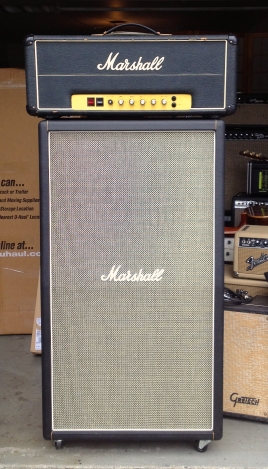
I installed a medium Marshall logo to match my head, but it’s otherwise an exact replica. Minus the stains, I mean.
Unable to track down a real ’68 8×10/4×12 of my own, I ordered one custom from Florida’s Sourmash Guitar Cabs, a company that makes amazing Marshall-style cabs at insanely affordable prices. They were all too eager to do another 1990 cab, and once it arrived, I was in love. It’s hilariously tall, and with that size comes a LOT of sonic power. Wired up with the same speakers as Rivers’ cab and my 50-watt head, it’s loud and thunderous; a massive cab both in size and sound. It’s my favorite cab, ever.
It’s an intimidating setup, both for myself and the sound techs unlucky enough to catch a glimpse of me loading in before showtime. I’ve actually surprised a few sound engineers with this one, one of whom told me, “When I saw you come in here, I thought ‘Oh no, look at this asshole. He’s gonna blow me out of the room,’ but you actually sounded great!”
I guess we both got lucky that night.
PEDALS
For this project, I’m not relying on pedals the way I normally do, what with my gigantic board and all. For lead boosts, I’m currently using a modified BOSS DS-1 with one of the diodes pulled for more volume. Aside from a TU-2, the only other pedal I’m using in My Name Is Jonas Brothers is my trusty Z.Vex Fuzz Factory to nail the fuzzy, octave-up sounds from certain Pinkerton tracks, such as the breakdown in “Pink Triangle” or the slower post-solo section of “The Good Life”.
That’s it for me. Soon, I’ll take you on a tour through the rigs of Mike Ball (as Matt Sharp) and our guitar player CJ Stout, MNIJB’s Brian Bell!
Like My Name Is Jonas Brothers on Facebook for show updates and pictures of Mike’s dog. And do yourself a favor and check out Weezer’s new record, Everything Will Be Alright In The End. It’s damn good.















